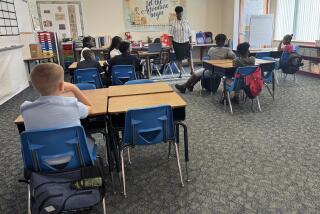Oakland Schools Study New Way to Handle Suspensions
OAKLAND — In this Bay Area city, where 25% of all middle school students were suspended last year, sending children home for behavioral problems in the classroom has become the rule, not the exception.
But the Oakland Unified School District, which forfeits state funding for each student it suspends, is considering a new approach to deal with disciplinary problems in-house and keep troubled children in school.
School board members are pushing to create suspension classrooms in each of the district’s 21 middle and high schools, something they have never done before.
“It’s a fairly common strategy for individual schools, but I don’t know of many districts that have such a policy,” said Mary Weaver, an assistant superintendent in the state Department of Education who deals with disciplinary issues.
The reason is simple: In most districts, the need for suspension classrooms doesn’t outweigh the cost of sacrificing regular classrooms.
“You don’t see it very often because for each school, you need an empty classroom and a teacher to staff it,” said Michael Karpman of the San Bernardino school district, one of the few California districts to adopt in-house suspensions. “So, a district has really got to have a problem with discipline for it to be worthwhile.”
Oakland, which last year handed out 4,933 suspensions, clearly does. (By contrast, San Francisco’s 35 middle and high schools issued 1,410 suspensions.)
Even after suspension classrooms are set up, Oakland students who commit serious offenses, such as bringing drugs or knives to school, still will be sent home. But the majority of incidents, defined loosely as “defiance of authority” and including anything from profanity to failure to complete a homework assignment, will result in on-campus suspensions. Under the proposal, these incidents will no longer be counted as suspensions.
Critics of the plan say it is more about raising revenue than correcting problem behavior.
Each day a student misses school in California, that district loses $21.66. In financially strapped Oakland, that is money that could be spent repairing dilapidated buildings, replacing old books and equipment or hiring teachers.
The in-house suspension program could bring the district up to $3 million a year. That’s more than enough, officials say, to offset the cost of hiring 21 new teachers, at an approximate cost of $50,000 per teacher in salary and benefits.
But members of Oakland’s school board, who enthusiastically support the plan, say money was not even a consideration.
“Students need the structure and direction you can only get by being at school,” said board President Noel Gallo. “Sending them home to an empty house to watch TV or roam the streets destroys motivation, self-esteem and accomplishes nothing.”
One thing the plan doesn’t address, however, is why the number of suspensions is so high to begin with.
“It doesn’t matter where you put them, at home or in a classroom,” said Sheila Quintana, president of the Oakland Education Assn., the teachers union. “The district has to be accountable for why so many students are being suspended.”
African Americans account for 50% of Oakland’s student body but make up 80% of all suspensions.
Oakland, which in 1996 became the only U.S. school district to officially recognize “Ebonics” as a second English language, has long struggled to better educate its African American students.
Part of the problem, some officials say, is that many Oakland teachers lack the experience to recognize cultural differences or prevent problems.
“The district hires too many teachers with no classroom experience,” said Quintana, who has been teaching in Oakland for 14 years. “They are in over their heads from the minute they arrive. For them, suspensions are a first option instead of a last resort.”
Quintana also says that warehousing groups of suspended students in separate classrooms won’t correct behavioral problems--and may only make them worse.
But board members, who are searching for funding to implement the plan next fall, say they expect the new suspension classrooms to hold fewer than a dozen students a day, a number teachers can easily control.
The board also says it intends to provide extra training so teachers will be better able to recognize which transgressions warrant a suspension and which do not. And to ensure that suspension classrooms don’t become breeding grounds for more disruptive behavior, students will be required to complete special academic assignments before returning to class.
More than anything, board members say, the plan will reestablish the fundamental importance of being in school.
“We as a district have failed to convey how sacred our schools are,” Gallo said. “We need to send the message to our students that this is the one place where they are always welcome.”
More to Read
Sign up for Essential California
The most important California stories and recommendations in your inbox every morning.
You may occasionally receive promotional content from the Los Angeles Times.










